Helping lots more young Americans get “to and through” four-year college degrees is a major goal of public policy and philanthropy. In 2009, President Obama set the target of leading the world in college completion by 2020. The Lumina Foundation aspires to increase the proportion of Americans with high-quality degrees, certificates, and other credentials to 60 percent by 2025. And the Bill & Melinda Gates Foundation has spent over seven years and half a billion dollars on strategies aimed at increasing college completion.

All of this has led to energetic initiatives inside and outside government to reform the higher education system and provide additional supports to first-generation students—the so-called “completion agenda.”
That’s all well and good. But as I’ve argued before, even these heroic efforts are unlikely to add up to much until we dramatically boost the number of young Americans who are ready for college in the first place. The best evidence of this proposition comes from the National Assessment of Educational Progress, which set a “college-prepared” level on its twelfth-grade assessments a few years ago (in addition to basic, proficient, and advanced). Chart 1 displays the percentage of twelfth-grade students nationally who have reached NAEP’s “college-prepared” level in reading and math over the past twenty-five years. (The 2015 numbers were released in April.) It also shows the percentage of students who matriculated directly to college, as well as the percentage of those who eventually graduated with bachelor’s degrees.
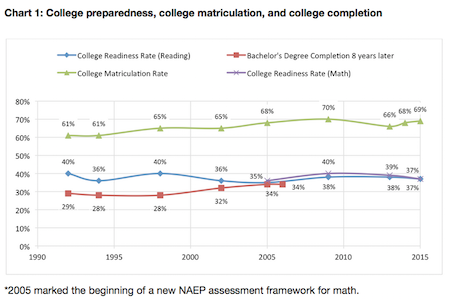
This picture is instructive on several counts. First, it shows that we’ve never gotten more than forty percent of high school graduates to a “college-prepared” level in reading or math. Keep in mind that these are the students who made it to twelfth grade; since about 20 percent of American students drop out, the proportion of all young people in a cohort of eighteen-year-olds who make it to the college-ready level in either subject is more like one in three.
Yet it’s also clear that young people continue to give college, well, the old college try. In 2015, even though just 37 percent of twelfth graders were college-prepared in reading and/or math, a whopping 69 percent enrolled in post-secondary education in the months after graduating from high school. Is it any surprise that remedial (a.k.a. “developmental”) education remains a growth industry on most community college (and some four-year college) campuses?
Finally, note the college completion data, which we now have for the high school class of 2007. About one in three students graduated college-ready, and about one in three students completed four-year degrees. In other words, the proportion of completers is about the same as the proportion of graduates who were college-ready. Interesting.
Now let’s see how these data look by race. Unfortunately, we have to limit our analysis to college preparedness in reading. (The keepers of the NAEP data won’t release “college preparedness” data for math by subgroup. In reading, “college-prepared” is set at the same level as “proficient,” so they have no choice but to make it available.)
Let’s start with white students:
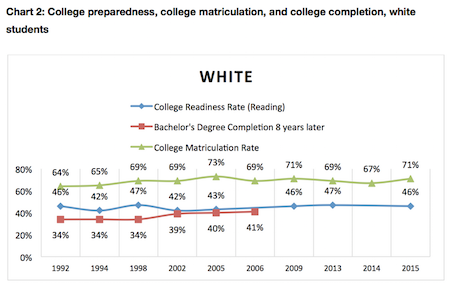
The picture looks largely the same as for the national sample, with slightly larger proportions of students graduating from high school at a college-prepared level, matriculating, and completing college. Once again, the proportion of completers is about the same as the proportion of graduates who were college-ready.
Now let’s turn to Hispanic students:
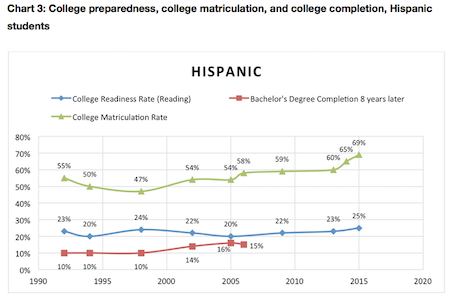
The picture is largely congruent, though the gap between college readiness (and completion) and college matriculation is even bigger than for the national sample. (Especially in recent years, as college entry for Hispanic students has skyrocketed.) There’s also a reasonably big gap between college readiness and college completion.
Now let’s tackle black students.
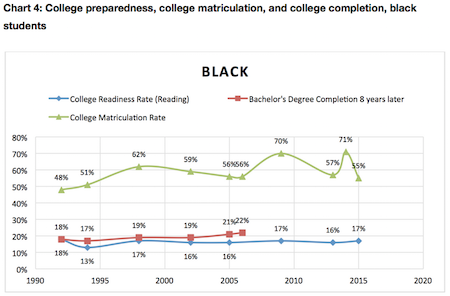
Now some bigger differences start to emerge. For one thing, the college matriculation numbers of late bounce around dramatically. (So dramatically as to make them somewhat suspect.) But also note: The red line in this picture is above the blue line, meaning that a greater proportion of black high school graduates completed college than tested at a college-ready level in twelfth grade. For the class of 2006, the difference was quite large—21 percent of black high school graduates completed college, but just 16 percent left high school at a college-ready level in reading (almost exactly the inverse of the numbers for Hispanic students).
Finally, let’s look at the picture for Asian American students.
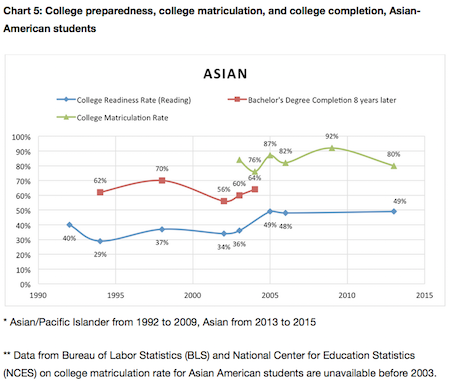
As you can see, the numbers across the board are much higher than for the other subgroups. A much larger proportion of Asian Americans graduate college-ready and matriculate. But note that, as with African American students, the red line is above the blue line. An astonishing two of three Asian American students who graduated high school in 2007 ended up completing a four-year degree. Yet less than half of Asian American students were reading (English) at a college-ready level in twelfth grade.
* * *
Can we make sense of these trends? Specifically, why might African American and Asian American students be doing better in terms of college completion than their twelfth-grade NAEP scores would predict?
For African American students, it turns out, this is a well-known phenomenon. (Not well known to me, but my friend and Education Next colleague Marty West brought it to my attention.) As this NBER working paper from 2006 explains, “Blacks get more education than do whites of similar cognitive ability.” The authors, Kevin Lang and Michael Manove, posit that because of discrimination in the labor market, “Education is generally a more valuable signal of productivity for blacks than for whites. As a result, blacks invest more heavily in the signal and get more education for a given level of ability.” In other words, because some employers won’t hire blacks without a college degree, they are even more motivated to get a credential than others.
And what about Asian Americans? Why are they doing so well in terms of college completion? Conventional wisdom would say that their families and cultures prioritize educational attainment and provide the pressure and support to make it likelier. Makes sense to me, though I’d love to see an empirical study on that.
Hispanics, meanwhile, appear to be the group for which the “completion agenda” has the greatest potential. As of the class of 2006, one in four Hispanic students who were ready for college didn’t complete a bachelor’s degree. Higher education reformers might find such students and do all they can to get them across the finish line.
Meanwhile, those of us in the K–12 world have our cut work out for us. If we want to see progress for American students—of all racial groups—we’ve got to get the college readiness rate past the forty percent mark and beyond. Otherwise, we will continue to set up millions of young people to fail.
—Mike Petrilli
This post originally appeared on Flypaper.
Sources:
The college enrollment numbers come from the National Center for Education Statistics’s Digest of Education Statistics, Table 302.20, for years up to and including 2013. 2014 and 2015 data come from the Bureau of Labor Statistics (BLS). NCES defines recent high school completers as “persons sixteen to twenty-four years old who graduated from high school in the preceding twelve months. Includes persons receiving GEDs.” BLS defines “recent high school graduates” as “persons who completed high school in the calendar year of the survey (January through October).”
In reading, the National Assessment Government Board estimates that “college-prepared” is equivalent to “proficient.” So these numbers are the percentage of all twelfth-grade students who were proficient in reading in those given years. In math, numbers are the percentage of all twelfth-grade students who were proficient in math in 2015, 2013, 2009, and 2005 (the first trend year for mathematics because of changes made to the assessment framework).
Bachelor’s degree completion numbers come from the National Center for Education Statistics’s Digest of Education Statistics, Table 104.20: “Percentage of persons twenty-five to twenty-nine years old with selected levels of educational attainment, by race/ethnicity and sex: Selected years, 1920 through 2014.
Special thanks to Andrew Scanlan, a research intern at the Thomas B. Fordham Institute, for collecting these data.


